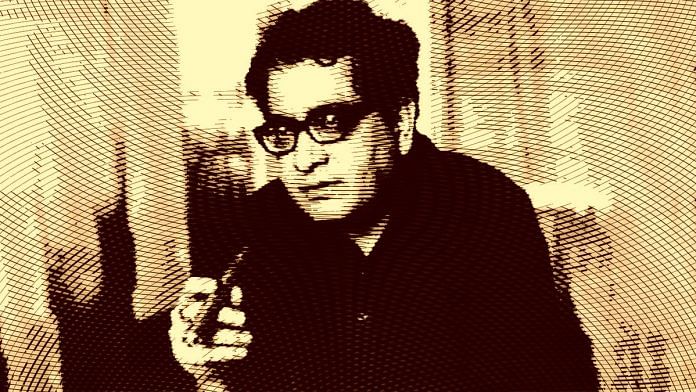New Delhi: He is referred to as a pioneer of the Nayi Kahani movement in modern Hindi literature, but Mohan Rakesh didn’t think there was anything ‘new’ in the movement.
“It is neither the newness of subject matter, nor the new or old or unfamiliar character portrayals that constitute the newly developed form of short story,” said the playwright and author in an interview to the Journal of South Asian Literature, published in 1968.
“Our emphasis was on the emergence of an idea through the reality itself, interpreting the reality around us. There was a sort of restlessness among us to capture the mood of our time. Nayi Kahani became a symbol for our effort to alienate the short story from what it was after Premchand.”
Connoisseurs of Hindi literature think of Rakesh as someone who brought forth the realities of the Indian middle-class lives through his characters. After the trauma of Partition, India was struggling to get back on its feet and keep pace with the modernising world around it. The Indians were trying to overcome the challenges of a changing society, and Rakesh portrayed their dilemmas in his short stories and plays.
Born on 8 January 1925 in Amritsar, Rakesh completed his Masters from Lahore. He started his career as a postman and changed many jobs before finally finding his true calling — writing.
His first collection of short stories, Insan ke Khandhar, was published in 1950. His next collection, Naye Badal, appeared seven years later in 1957 followed by Janwar Aur Janwar (1959), Ek Aur Zindagi (1961) and Faulad Ka Akash (1966). But he is perhaps best known for his plays, notably Ashadh Ka Ek Din (1958; his first), Lehron Ke Rajhans (1963), Adhe Adhure (1969) and Na Aane Wala Kal (1968).
Rakesh died on 3 January 1972. On his birthday anniversary, ThePrint shines a spotlight on this important writer and his works.
Also read: Girish Karnad’s last work was an unfinished autobiography in English
Disillusionment of urban middle class
“There is an unending quest for something new. The characters go through a similar dilemma stuck in a fast changing world around them,” author-filmmaker Surendra Manan tells ThePrint. “In Lehron Ke Rajhans, Ashadh Ka Ek Din and similar other writings of Rakesh, we find the characters trying to challenge the status quo in order to break free from the gloom and stillness of life, but yet they fail.”
Theatre director and writer Kuldeep Kunal describes Rakesh’s plays as “forever relevant and closer to realism”. Kunal, who re-adapted Ashadh Ka Ek Din, based on Kalidas’ life, to a contemporary setting, struggled with recreating the brilliance on stage.
“My favourite adaptation of it was done by renowned Punjabi playwright the late Balraj Pandit, even better than many of its Hindi adaptations,” he tells ThePrint. “One thing I really liked about his characters is that there is no judgement of right or wrong. Every character is in a grey zone, which connects with the reader.”
Language as a tool
Noted writer translator Rajinder Paul says Mohan Rakesh “struggled like a sculptor with the stony language of Hindi to sharpen its edges”. In an interview to Mohan Maharshi, Rakesh said, “I want to go close to that language which is the language of being and not merely the language to know.”
And he used language in different ways to tell different stories. “There is not a particular style of language one can find common in his plays,” Surendra Manan tells ThePrint. “Ashadh Ka Ek Din has the influence of Sanskritised poetry as it is based in a different era, inspired by Kalidas’s life. In Adhe Adhure, the language is very simple, reflecting the times the play was based in.”
Women in his plays
“Rakesh’s women are exceptionally strong in dealing with the pressures of convention or circumstance, and so memorably vital that he has often been accused of rendering his male characters too weak and vacillating,” writes professor and author Renu Juneja in the Journal of South Asian Literature.
Whether it is Mallika from Ashadh Ka Ek Din or Sundari from Lehron Ke Rajhans, no two characters are the same. “While Mallika is an emotional woman, Sundari is a victim of her conditions… In Adhe Adhure, Savitri represents the consciousness of a practical woman who is caught in the process of change, dealing with her ‘good for nothing’ husband,” Kunal tells ThePrint.
Rakesh received the Sangeet Natak Akademi Award in 1968. He passed away in 1972 when he was only 46 years old.
Also read: Celebrating PL Deshpande — the ‘RK Laxman of prose’




मोहन राकेश जी हिन्दी साहित्य के मूर्धन्य साहित्यकार थे।उनका लिखा साहित्य यकीनन् हिन्दी साहित्य की अमूल्य धरोहर है।
आपका लेख लाभप्रद रहेगा।
मनोज शर्मा